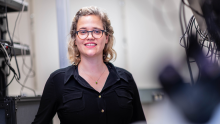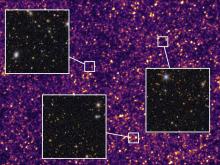Canada’s suitcase-sized MOST space telescope celebrates its 10th birthday in space this Canada Day weekend with new details on a distant super-Earth, and a renewed call for amateur astronomers to submit targets for the satellite.
"Over the years we’ve always half-joked that MOST could stand for My Own Space Telescope,” says MOST mission scientist and UBC astrophysicist Jaymie Matthews. “This is a chance for an armchair astronomer to teach the world about new worlds around other suns, and to celebrate Canada’s and MOST’s birthdays."
Weighing only 54 kg and powered by solar panels, the Canadian Space Agency telescope is packed with gear to study stellar variability--a snapshot record of a star’s light variations. After ten years in orbit, the veteran instrument continues to generate results.
New findings based on MOST data have pinpointed the size and mass of HD 97658b, an exoplanet 70 light-years from Earth.The results will be published online Monday in Astrophysical Journal Letters.
"Measuring an exoplanet's size and mass leads to a determination of its density, which in turn allows astronomers to say something about its composition," says Diana Dragomir, a postdoctoral astronomer with the University of California Santa Barbara who conducted the research while at UBC.
"Measuring the properties of super-Earths in particular tells us whether they are mainly rocky, water-rich, mini gas giants, or something entirely different."
A super-Earth is an exoplanet with a mass and radius between those of the Earth and Neptune--the term refers to the planet’s mass and doesn’t imply similar temperature or environment to Earth. The brightness of the star that HD 97658b orbits allows astronomers to study the star and planet in ways not possible for most exoplanet systems around fainter stars.
"A picture is worth a thousand words," says Matthews. "But this proves a hundred thousand pictures from MOST are worth a close-up of a star system a thousand light years away."
Any Canadian can submit ideas for targets for Canada’s space telescope at http://most.oracology.net. The site contains tools to select viable targets and links to make the rocket science more accessible. The MOST team judges the submissions twice a year and selects one or two to pursue.
About MOST
- MOST was launched from northern Russia in June 2003 aboard a converted Intercontinental Ballistic Missile.
- MOST stands for Microvariability and Oscillations of STars. UBC is the main contractor for the instrument and scientific operations.
- MOST makes use of commercial-grade electronics and early prototyping engineering to achieve low costs in comparison to most satellite projects. Its life-cycle cost is less than $10 million.
- In 2006 MOST observations revealed a previously unknown class of variable stars--slowly pulsating B supergiants.
- In 2008 the MOST team won the Canadian Aeronautics and Space Institute's Alouette Award for its contributions to Canadian space technology, applications, science or engineering.
Armchair Astronomer Discoveries with MOST
- Gordon Sarty, an amateur astronomer from Saskatoon, Saskatawan was able to use MOST to investigate a mysterious micro-quasar--a hot star in an orbital dance with a companion that might be a black hole.
- David Gamey, a Cub Scout leader in Etobicoke, Ontario, told the MOST team his troupe thought the coolest star in the sky was Betelgeuse. Gamey’s suggestion to observe this supergiant star (pronounced Beetlejuice) led to detailed measurements of the envelope of one of the brightest stars in our night sky.


